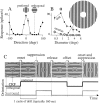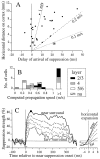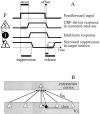Time course and time-distance relationships for surround suppression in macaque V1 neurons
- PMID: 12930809
- PMCID: PMC6740744
- DOI: 10.1523/JNEUROSCI.23-20-07690.2003
Time course and time-distance relationships for surround suppression in macaque V1 neurons
Abstract
Iso-orientation surround suppression is a powerful form of visual contextual modulation in which a stimulus of the preferred orientation of a neuron placed outside the classical receptive field (CRF) of the neuron suppresses the response to stimuli within the CRF. This suppression is most often attributed to orientation-tuned signals that propagate laterally across the cortex, activating local inhibition. By studying the temporal properties of surround suppression, we have uncovered characteristics that challenge standard notions of surround suppression. We found that the latency of suppression depended on its strength. Across cells, strong suppression arrived on average 30 msec earlier than weak suppression, and suppression sometimes arrived faster than the excitatory CRF response. We compared the relative latency of CRF response onset and offset with the relative latency of suppression onset and offset. Response onset was delayed relative to response offset in the CRF but not in the surround. This is not the expected result if neurons targeted by suppression are like those that generate it. We examined the time course of suppression as a function of distance of the surround stimulus from the CRF and found that suppression was predominantly sustained for nearby stimuli and predominantly transient for distant stimuli. By comparing the latency of suppression for nearby and distant stimuli, we found that orientation-tuned suppression could effectively propagate across 6 - 8 mm of cortex at approximately 1 m/sec. This is considerably faster than expected for horizontal cortical connections previously implicated in surround suppression. We offer refinements to circuits for surround suppression that account for these results and describe how feedback from cells with large CRFs can account for the rapid propagation of suppression within V1.
Figures








References
-
- Albright TD, Stoner GR ( 2002) Contextual influences on visual processing. Annu Rev Neurosci 25: 339-379. - PubMed
-
- Allman J, Miezin F, McGuinness E ( 1985) Stimulus specific responses from beyond the classical receptive field: neurophysiological mechanisms for local-global comparisons in visual neurons. Annu Rev Neurosci 8: 407-430. - PubMed
Publication types
MeSH terms
Grants and funding
LinkOut - more resources
Full Text Sources
Other Literature Sources
